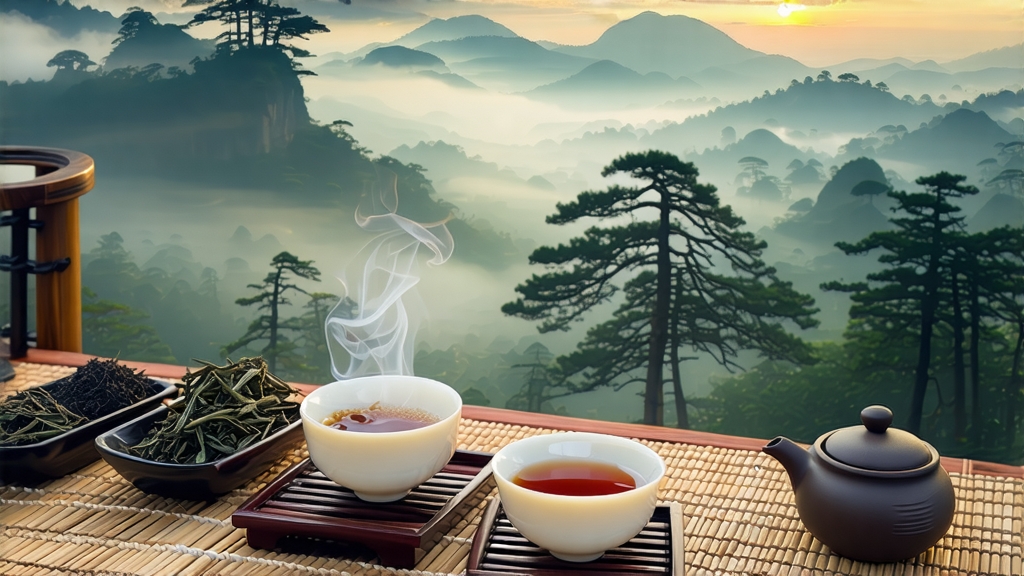
Long before English breakfast blends and afternoon tea services, there was Lapsang Souchong—the original black tea that startled European palates in the early seventeenth century and redefined what “tea” could taste like. Grown in the rocky core of Fujian’s Wuyi Mountains, this leaf carries the memory of pine torches, horse caravans, and the first global commodity boom. To understand Lapsang Souchong is to witness the moment when Chinese ingenuity met world demand, producing a tea that is at once a comfort and a curiosity, a campfire in a cup and a liquid archive of maritime trade.
History: From Wuyi Cliff to London Coffeehouse
Local legend says the smoke-drying technique was born of accident: Qing-era soldiers quartered in Tongmu village delayed the usual leaf-drying schedule, so farmers rushed the process by firing fresh leaves over pinewood to meet market day. The improbable result—brisk, resinous, mysteriously sweet—reached Amsterdam in 1604 via Dutch merchants who marketed it as “bohea,” a corruption of the Wuyi range’s name. By the 1660s Catherine of Braganza had made it fashionable at the English court, and the British East India Company listed “Souchon” (a phonetic stab at “Xiao-zhong,” meaning “small-sort”) among its most valuable cargoes. The tea financed porcelain shipments, sparked clipper races, and indirectly seeded the habit of adding milk and sugar to tame its smoky edge. Thus, the first black tea ever exported is still the only one intentionally cured over burning pine.
Terroir & Leaf Style
Authentic Lapsang Souchong comes from a 120-square-kilometer UNESCO buffer zone where subtropical mists rise from the Nine-Bend River, cooling tea bushes rooted in weathered tuff and granite. Only two cultivars are permitted: Xiaozhong (small-leaf) and the more aromatic Wuyi Qizhong. Spring plucking follows the “two leaves and a bud” rule, but the leaves are deliberately allowed to grow slightly larger than green-tea standards, building polyphenols that will later polymerize into maltol and smoky aromatics. The highest grade, called “Zhengshan Xiaozhong,” is picked before Qingming festival at 800–1 200 m elevation; leaves show tight fish-hook shapes covered in tawny down, a sign of slow mountain growth.
Craft: Where Fire Meets Flesh
The processing choreography begins with withering on bamboo racks set inside wooden huts warmed by gentle pine embers—this “warm wither” reduces moisture while impregnating the leaf with volatile guaiacol and syringol. Once the leaf becomes supple, rollers break cell walls to initiate oxidation. The critical twist comes after fermentation: instead of hot-air baking, workers spread the blackened leaf 1 cm deep on sieves suspended over a pinewood hearth. A fresh fire is lit, allowed to flame for seconds, then smothered to produce cool, aromatic smoke that drifts upward for 6–8 hours. Master smokers gauge readiness by sound: when the crackle of resin subsides into a soft hiss, the tea has absorbed just enough smoke without turning acrid. A final charcoal bake at 80 °C fixes the flavor, after which the leaf rests in linen sacks for one month so smoke and tea oils marry.
Grades & Flavor Spectrum
International markets often meet only the heavily smoked “Russian caravan” style, but connoisseurs recognize at least four grades.
- Traditional Pinewood Lapsang: cool-smoked, cocoa-black leaves, scent of pine sap and longan, liquor bright copper, taste of honeyed ham and dried lychee.
- Wuyi Smoky Zhengshan: subtler smoke, more mineral “yan yun” (cliff rhyme) reminiscent of Wuyi rock oolongs, finish of cinnamon and ripe peach.
- Unsmoked Xiao-zhong: processed like black tea but dried with hot air; malty, raisin-sweet, favored in Fujian as a breakfast tea.
- Special Aged Lapsang: stored in earthen jars for 3–5 years; smoke recedes, revealing notes of sandalwood, dark chocolate, and camphor.
Chemistry in the Cup
Gas-chromatography studies identify 42 phenolic volatiles unique to pine-sm